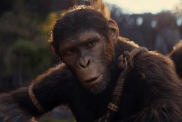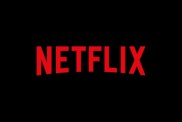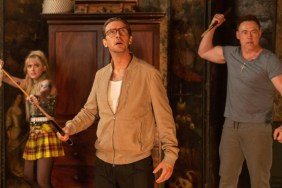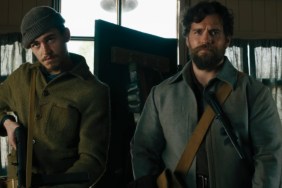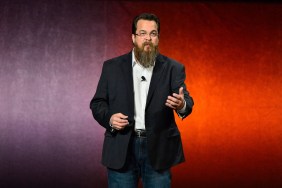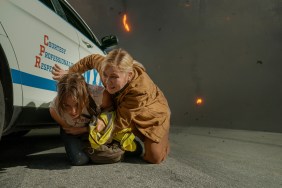
This November, Walt Disney Animation Studios is going to be turning down the temperature, presenting its 53rd feature film, Frozen, loosely inspired by Hans Christian Andersen’s “The Snow Queen.” The kind of fairytale adventure that audiences haven’t seen since 2010’s Tangled, Frozen features the voice talents of Kristen Bell, Idina Menzel, Jonathan Groff, Santino Fontana, Josh Gad and Alan Tudyk as well as brand new songs by the “Avenue Q” and “The Book of Mormon” pair of Robert Lopez and Kristen Anderson-Lopez.
Frozen tells the tale of two sisters, Anna (Bell) and Elsa (Menzel), the latter of whom has supernatural powers that can control ice and snow. When Elsa uses her abilities to unleash an eternal winter, Anna joins forces with a mountain man, Kristoff (Groff), his reindeer, Sven, and a magical snowman, Olaf, to traverse an ice-covered landscape in the hopes of thawing out their kingdom.
ComingSoon.net had the opportunity for an early conversation with directors Chris Buck and Jennifer Lee. Buck’s past co-directing credits include Tarzan and Surf’s Up while Frozen marks Lee’s first, having recently worked as one of the screenwriters on the studio’s Wreck-It Ralph. In the below interview, the pair discuss the origins of their partnership, the need to develop Elsa as a three-dimensional antagonist and the extensive research that went into making their depiction of Norway as accurate as possible.
CS: It seems much more common in animation than in live action to have directors working in pairs. Could you tell me a little bit about the beginning of your creative partnership?
Jennifer Lee: I hated him! I used to talk smack about him all the time. (laughs) No, not really.
Buck: Well, Jen jumped on just a couple of years ago at Disney.
Lee: I was doing writing on “[Wreck-It template=’galleryview’]–> Ralph” and had come in to give notes to their pitches and things like that as we do with each other’s films. So we knew each other and they asked me to come in as a writer and so, for six months, we were a writing/directing team and I think John [Lasseter template=’galleryview’]–> and Ed [Catmull template=’galleryview’]–> really saw something in us together. How we worked together and we just instantly kind of fit.
Buck: We already knew from the notes she gave that she really understood this movie, at least the vision that I had for it. I didn’t exactly know how to get there yet, but she was instrumental in getting us there.
Lee: He’s also very patient and I’m not. It was a good ying-yang. John knowing our schedule and that the story had to keep evolving, I think he thought it was a good idea if I could just jump on and co-direct. Then I could keep story running when he had to do production. Or, sometimes, vice versa. I was still learning the production. Mostly, though, we were together except for those moments where I would work with a story team for an afternoon and work with story design, getting things together and getting them to continue to move. I’m very grateful that John saw that I could handle that and that he was all for it. I’m grateful to him.
Buck: It’s been great. It’s been really, really good. I mean, there are times where we’ve had disagreements here and there, but usually it’s easy to see either, “yeah, that’s going to make the idea better” or, if someone feels really passionate about something, we let them try that out.

Lee: It’s good when you have someone to bounce things off of, because you really have to justify anything that you think will be good for the movie. You really do because nothing should be superfluous at all. If one of us is unsettled by something and the other really thinks it belongs, you have to know why. If you can’t argue for it, maybe there’s something you’r not seeing. It’s a really great way, I think, of driving the film to be better and better by always having someone there to, sometimes call B.S. on you and other times to say, “Wow! I just got this new idea!”
Buck: Yeah. And it’s also a big, big team of people that we’re working with. We get a lot of input, storewide included. There are times where we may believe in something and the rest of the crew is saying, “No, that’s not going to work!” You always have the other person to ask, “Am I crazy?” It’s always good to have that partner to say, “No, let’s keep going. I think we’ve got something.”
CS: When you’re working on a live-action movie, that process tends to happen at the script stage. It seems like there’s something very malleable about how an animated film is formed all at once.
Lee: Yes and, as a writer coming into it, it’s hard. “Ralph” was like boot camp every day because people are constantly affecting the work. Screenwriters are usually very analytical, always thinking of the whole structure and how everything has to work together. These great ideas are thrown in and you have to be flexible and also protect the story. Sometimes you’re there alone, fighting. Saying, “You can’t do that because you’re going to destroy all the emotion in the character!” You have to do that, but you also have to be very flexible, too. It’s just fabulous when a story artist comes in with something. Usually the director and the writer are a really strong team anyway whether it’s two directors or a writer and a director. It was always very easy for us because I could just go to him and say, “The story team is pulling it apart.” We would make a point of going in together and saying, “This is amazing, but we need to protect this.” It’s a part of this process that’s sort of old traditions of animated films not always being made with scripts. They were made by story artists out of different sequences and they’re storytellers. You want to respect that and you want to preserve that because it’s part of what makes animated films so special and flexible and speak to so many different people. You can’t really do that today with the amount of complexity that a story needs to be now to audiences who have seen it all. You really want to keep driving them and take the story to a bigger place where it will most resonate, but you also need that structure that only writers can provide. It’s a very unique situation as a writer. Live-action is much easier! (laughs)
CS: One of the interesting angles in “Frozen” appears to be that you have an antagonist who is not necessarily a villain and I’m curious as to how early that became a part of the story.
Buck: She started as a villain. Elsa, if that’s who you’re talking about. It was a just a matter of finding her way. She was such a fascinating character and that led us to make her more three-dimensional and not so much one note. Less of a villain and more of a, “Who is this person? Who is she really?”
Lee: John [Lasseter template=’galleryview’]–> is really an interesting guy as a storyteller because the villains are not really his favorite part. If there is a villain, for him, you really need to understand him or her. There needs to be a reason that they are a villain. It can’t just be for villains’ sake. Oftentimes, when you do that, you end up with much more complex characters. We have antagonists through the whole film who are people that exploit the themes of love and fear. We’re not giving those away, but we have them. Elsa certainly was not as interesting when she was just a villain, unlike now where she’s so torn and ruled by fear. John pushes it because he thinks that’s far more interesting.
Buck: And it is. It turned out to be much, much more interesting than some of the earlier versions we had.

CS: Walt Disney Animation Studios had a really interesting research phase of pre-production where people traveled to various locations to take photos. I know the travel for “Frozen” included an actual ice hotel.
Lee: I wish I got to go! On “Ralph,” I got to go to Glendale to a video game chop shop.
CS: That’s still pretty cool.
Lee: That was awesome. But they were already in Norway when I joined. I was like, “So we’re going to Norway?!” and they were like, “They’re already there.”
Buck: I didn’t get to go either. We all had to hunker down and get the story working. But yeah, the research is so integral to all of these movies. How to bring a sense of — not realism, but believability — to our films. There’s always something to jump off. Things you would never think about when you say, “I want to go to Norway and look at the fjords and this and this and this.” There are these little side things that happen that you never knew were going to happen.
Lee: And details, too. We ended up bringing a lot of consultants in for us while we were here. We have a lot of old Norse in the film and we have a guy who knows about, for instance, Norwegian weddings. They have soup, roast and ice cream. As a writer, you’re always looking for specificity. That’s the key. You never want generalizations. That’s boring. Anytime you can find something that feels authentic, even if you change it a little, it makes it more alive. That’s where you go to believability. To have these research trips and to be inspired by actual things, just kind of raises it a level.
Buck: One of our artists brought back a CD that they found of this gorgeous music that we all fell in love with. We didn’t know where we were going to use it and it ended up being the beginning of our movie. It’s this gorgeous Norwegian choir. We don’t use that exact piece. We went and approached them and they ended up recording a new piece for us.
Lee: Christophe Beck, who did the score, and Tom MacDougall, our music supervisor, went to Norway and recorded with the original composer and the original choir because we were all so moved by it.
Buck: It was one of those things. It was just a fluke that one of our artists found this CD.
Lee: It shaped so much of the world. It really transported you and told you you’re somewhere else that you’ve never been. There was no other way we could open the movie.
Frozen opens in theaters November 27. Check out new concept art and images in the gallery below! You can also watch the trailer underneath.
Frozen
-
Frozen Northern Lights

-
Frozen Northern Lights

-
Frozen Northern Lights

-
Frozen Northern Lights

-
Frozen Northern Lights

-
Frozen Northern Lights

-
Frozen Ever After

-
Frozen Ever After

-
Frozen

-
Frozen

-
Frozen

-
Frozen

-
Frozen

-
Frozen

-
Frozen

-
Frozen

-
Frozen

-
Frozen

-
Frozen

-
Frozen

-
Frozen

-
Frozen

-
Frozen

-
Frozen

-
Frozen

-
Frozen

-
Frozen

-
Frozen

-
Frozen

-
Frozen

-
Frozen

-
Frozen

-
Frozen

-
Frozen

-
Frozen

-
Frozen

-
Frozen

-
Frozen

-
Frozen

-
Frozen

-
Frozen

-
Frozen

-
Frozen

-
Frozen

-
Frozen

-
Frozen

-
Frozen

-
Frozen

-
Frozen

-
Frozen

-
Frozen

-
Frozen

-
Frozen

-
Frozen

-
Frozen

-
Frozen

-
Frozen

-
Frozen

-
Frozen

-
Frozen

-
Frozen

-
Frozen


